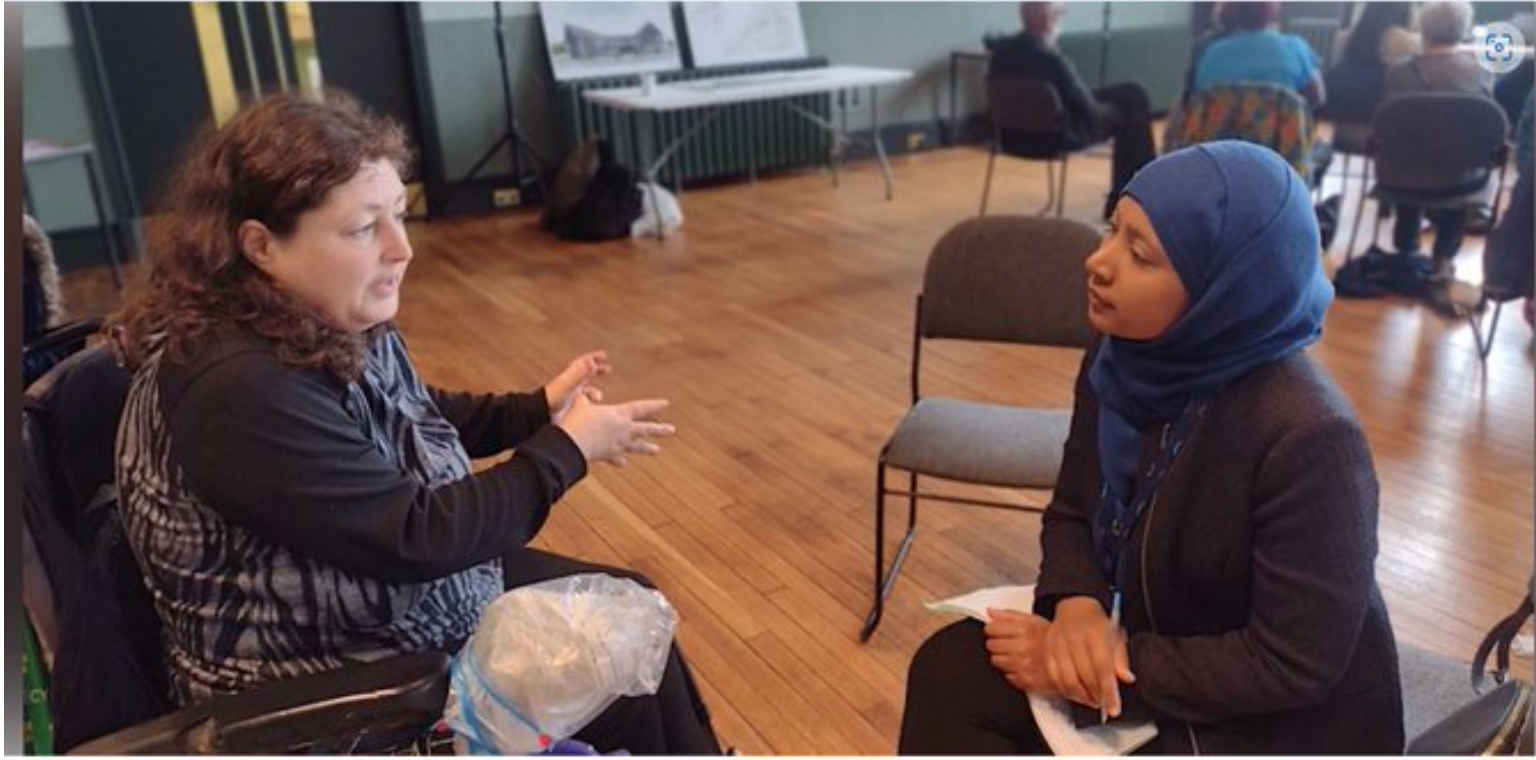By Lily Gordon Brown (@lilygbrown)
Introduction
The last decade has seen the UK steeped in a crisis of several iterations, as governments have sought to shift the fiscal consequences of the 2008 financial crash on to local communities. This includes councils up and down the country deliberately being forced to selling off public land to plug gaps in their budget deficits.
Whilst a number of community movements have risen in response to these crises of financialisation, especially potent in the rise of tenants’ unions across the UK, it is difficult to envision a full upheaval of the now hegemonic transactional relationship between local authorities and ‘speculative’ property investors. Despite their mantra of ‘development’ and ‘growth’, such investors have little intention of bettering the UK’s local body politic, nor its socioeconomic wellbeing.
Notwithstanding the value and hard work of tenants’ unions and their community counterparts, one is forced to question whether it will be enough to initiate large-scale systematic change. Whilst such movements will (and should) continue to mature and grow at speed, new local ideas are concurrently coming to the fore.
One issue unfolding this year has been mounting tensions between central government and northern cities such as Liverpool and Manchester. Whilst the past fortnight has witnessed mayor Andy Burnham take on and undermine Westminster’s attitude toward the furlough scheme in the Greater Manchester region; metro-mayor of Liverpool’s Combined Authority (CA), Steve Rotherham, has recently established a local Land Commission in the Liverpool City Region (LCR), tasked with spearheading a new approach to land and the community.
In identifying the responsibilities of the commission, Steve Rotherham announced that he had ‘challenged’ the commissioners to think up ‘radical recommendations for how we can make the best use of publicly-owned land to make this the fairest and most socially inclusive city region in the country.’ The commission is set to evaluate the current status quo of land in the LCR: it’s uses, it’s treatment and, later, it’s potential. It will then produce a report of recommendations on their findings.
Although not the first commission of this kind to be instituted in a UK context, it is certainly a sign of something more radical to come. Moving beyond the traditional ‘boss politics’ entrenched in local authority institutions, the commission is constituted by an amalgamation of academics, Community Land Trust (CLT) creators, Community Interest Company (CIC) directors, and pioneers within the world of land and regional planning. It is facilitated by the Centre for Local Economic Strategies (CLES).
Through the help of Riverside councillor Sarah Doyle, I was afforded the opportunity to speak with two of the commissioners, Dr Matthew Thompson [Matt] and Liam Kelly. Those in the housing movement may have heard Matt’s name through the release of his new (and might I say, very worth-a-read) book: Reconstructing Public Housing: Liverpool’s Hidden History of Collective Alternatives. He is a Leverhulme Research Fellow at the Heseltine Institute of the University of Liverpool, the irony of the institution’s name lying in Michael Heseltine’s role in the inner-city regeneration and infusion of ‘entrepreneurialism’ into Liverpool, both chief culprits the LCR’s current predicaments on land and its uses. Matt also writes for Minim, a magazine which aims to ‘amplify the voice of municipalism by sharing practical and theoretical knowledge’ currently blossoming amongst activists, scholars, journalists, and public officials.
Liam, on the other hand, has worked on the frontlines of community wealth building in the Liverpool City Region for a number of years, and currently heads Make CIC- one of the LCR’S many burgeoning creative organisations, which collaborates alongside the community to create a ‘magnet for creatives, makers, dreamers and doers’. Liam also sits on a number of other panels and boards looking to better the city and it’s several districts, including a Town Centre and High Streets Commission which is still ongoing.
We spoke at length about the commission’s inception, its findings, its challenges and its general duties. It is worth noting that although the commission has (virtually) met four times since September, their report has not yet been compiled. Perhaps indicative of the obstacles we face at the prospect of democratising land in the UK, the commission are planning to meet more frequently than initially agreed by the Combined Authority and CLES.

The commission’s inception in the Liverpool City Region
Following his electoral victory in Merseyside in 2017, metro-mayor Steve Rotherham was quick to announce an agenda focused on building ‘inclusive growth’ in the Liverpool City Region. While an easy phrase to use, Liam and Matt both cited some concern amongst activists, land planners and those hopeful urban transformation that such ‘growth’, partnered with a desire for increased municipal devolution, may sound attractive but become little more than a buzzword in practise.
The appointment of the commission diminishes some of the initial doubts, signalling that the Combined Authority are at least taking things seriously. As Liam pointed out, “CLES were an obvious fit” when it came to Rotherham assigning a facilitator; their strength lies in democratic community building, and they already had a “strong footprint in the LCR and beyond”.
Though the commissioners weren’t privy to the decision-making process prior to the commission’s existence, it is expected to have been in the works for a time predating the pandemic. However, it was likely to have been accelerated by the socioeconomic upshots of Covid-19, which have been particularly vicious across the North West. In an article on the Combined Authority’s website, Rotherham specifically mentions Covid-19: “The unprecedented circumstances of the COVID-19 pandemic, with all its economic consequences, make it even more important for us to ensure that we can wring the maximum possible community value from our land assets to encourage sustainable economic recovery.”
As a researcher at the University, Matt revealed what is perhaps best termed a process of academic lobbying undertaken by the Heseltine Institute. Members of the institute have composed several urban planning reports and recommendations over the past few years. On at least one occasion, Matt noted that they had raised a cooperative land commission, and “invited Rotherham to seminars and conferences to listen to their proposals”. These proposals were intended to map the potentialities of socialising and democratising land value in the LCR. Rotherham has clearly listened. The relationship between the institute and the CA has only developed, with Rotherham unofficially designating them as an “inhouse research group” in urban planning.
Furthermore, Rotherham’s decision clearly feeds into a wider trend unfolding across the UK. As Westminster continue to neglect its duties anywhere beyond its elitist bubble, local leaders have been calling for devolved power to be handed back to those allied with the communities they represent, recently most patent in the LCR. This new political pathway should certainly be welcomed.
Matt describes this as a process of “competitive city branding”, with local leaders emphasising their innovative approach at most given opportunities. He is not, however, critical of such emphasis. Blowing your own trumpet about forward-thinking development is more than necessary in the grossly undemocratic decision-making structure the UK is currently plagued with, so long as the Combined Authority’s campaign evolves past the ever-more enticing prospect of establishing a political ‘brand’.
In turning to the LCR itself, and what makes it fertile ground for a land commission to operate, Liam told me “the human and physical geography of the LCR plays into a unique set of circumstances.” It is not just Liverpool’s vast Victorian infrastructure which lends itself to a reconceptualisation of land ownership, but also its surprisingly small population. As it happens, these two factors are inextricably linked. Liverpool was designed to house an ever-expanding urban population. Yet, in the second half of the twentieth century, the city’s populace declined rapidly, largely a product of the war; inner-city displacement; and, later, the unemployment fallouts of de-industrialisation. Thus, unlike its still-bustling northern neighbour Manchester, the city region’s land mass is largely empty, as are many of the buildings that occupy it.
Such low population density doesn’t necessarily serve the city region well. The city centre of Liverpool, and some of its district counterparts like Birkenhead and Halton, are often quiet and thus suffer a deprivation of cultural and economic activity. A reimagining of vacant land and its uses would look to remedy this deficit of city-wide social interaction, and in turn stimulate economic movement.
A democratic-commons ownership model must become an integral part of this reimagination. Whilst private property-led regeneration strategies have done little to stimulate cultural interaction across the LCR, communities being given a say in what happens to the land they occupy will have a better chance of encouraging community activity. We just have to look at the successes of the likes of Granby4Streets, where land is being used to breed increased sociability, such as the establishment of a community-owned winter garden.
One can also look to the long anti-authoritarian history of Liverpool. Whilst the 1980/90s saw the city engaged in ideological warfare with the Thatcherite cabinet, more recent decades have seen an increasing disconnect between Liverpool and the country’s political centre. Local officials have made concerted efforts to release the LCR from the strangle-hold of Westminster decisions. Some headway was made in 2015, when a Devolution Agreement was signed. Not without its limits, the agreement was an own goal by Westminster, offering a degree of leverage for greater autonomy in the already disillusioned city region; since signing such agreements, local actors have acted increasingly ‘awkward’ in the eyes of parliament, not abiding by the first chamber’s modus operandi.

As Matt pointed out, Liverpool has a profound history of “sticking it’s middle finger up to elitist authority”, making it all the more suitable for democratising land currently dominated by those at the intersect of politics and financial markets. The region has also been a hotbed of cooperative community action, from the inspiring history of CLTs like Homebaked and Granby4Streets, to the success of CICs such as Make CIC and The Beautiful Ideas Co. Neither should go unheeded in assessing the rationality behind the inauguration of the land commission, whilst such success is deserving of their own journalistic attention.
The commission’s functions & discussion points
Matt opts to see the commission as a “pop up thinktank or community-based task-force.” Unlike the Scottish Land Commission (SCL), which the LCR takes much inspiration from, Rotherham’s commission is not a sitting one. Rather, it is temporary vehicle for change, which must be followed up by a longer-lasting plan. It is worth noting that Kathie Pollard, a policy director on the SCL is also a member of the LCR board. Liam has been working closely with Kathie to design some recommendations to suit the LCR’s individual needs, drawing on her extensive experience.
Both Matt and Liam identified the “nebulous” and potentially long-term goals of the commission as an achilles heel in the opening stages of discussion. Whilst a radical policy agenda in the LCR is something the commissioners, and many of us, would like to see, it is vital that the document remains both scrupulous and pragmatic. This means moving beyond the sometimes-vague bold ideas of ‘community wealth building’, ‘democratic land ownership’ and ‘housing for all’. It is not that such ideas lack concrete theory or effective examples, but that they need to be adapted to suit the LCR’s landscape- a chief task of the commission.
It also means engaging in the nitty-gritty of stalled land development sites and anti-social land-banking, both endemic in the LCR. It means advancing beyond the ‘sexy’ (but still important) big-ticket items down to revamping “shutters on high street shop windows”. It is vital that the discourse around democratic land ownership covers the multi-layered elements of a burgeoning community, some of which are cited in the ‘Land for the Many’ report produced for the Labour Party in 2019, found here.
Whilst there exists an often-misconstrued interpretation that land ownership merely refers to housing, both community wealth building and the concept of property traverse several realms. The commission will likely report on issues from “rewilding, re-greening (mapping more green space), to the increasingly tarnished appearance of the ‘high street’, food production”, or even the shortage of allotments in local communities across the city.
Matt and Liam both cited the need to define a permanent and transparent strategy for land use, rather than “meanwhile use policies”, the latter of which refers to a process whereby land is bought and developed on a ‘meanwhile’ basis, failing to encompass a long-term strategy for use. This permits developers to operate on a short-term premise, which in turn tends to disadvantage communities in the surrounding areas. Permanence would encourage commitment, something the LCR would appreciate both economically and socially.
There potential for a disconnect to emerge between the land commission’s body and communities on the ground. Most importantly, this comes in the form of democratic participation, and ensuring this is not just another case of experts leading the commons, but rather the other way around. In confronting this, the commissioners expressed a desire for some form of ‘legacy’ body to pursue their findings. Whether intermediary or permanent, this body would look to accelerate actions, and would hopefully incorporate more community members in active participation going forward.
The commission is thus a first step, a ‘lobbying document’, in what really needs to be a prolonged and sustained chain of subsequent events. It is likely that commissioners will submit short statements in order that the report and its findings can be made relevant to a wider audience.
Once the report is compiled, it is left in the hands of CLES, the Combined Authority and Mr Rotherham. We can only hope that actions really do speak louder than words. Rotherham has been ambitious enough to give radical thinkers the space to map out and pool together their ideas. His response to their findings will provide an opportunity to assess the actualities of the Combined Authority’s policy agenda.
Potential Challenges
There is little doubt that even if the commission and its findings get past their embryonic stages, resistance will be extensive. This pushback will come in multiple forms: the corporate-capitalist elite, with a current socioeconomic investment in land across the LCR; Westminster, including Labour Party members; and, perhaps more surprisingly, local authorities.
Local authority pushback derives from a number of reasons and deserves some attention. For one: fear. Many local officials have occupied their positions their whole lives, ‘lifers’ as Liam described them, and have a lot to lose from passing down authority.
But more, these people are “working in a different paradigm”. They retain an ostensibly ‘mature’ outlook on public spending, whereby “silly little committee group” [Matt] should not be granted access to the political machinations usually reserved for the state.
Perhaps most obviously, the material constraints faced by local authorities since the onslaught of austerity act as the greatest barrier. Whilst councils selling off public assets to speculative investors with little negotiation required appears both ludicrous and indefensible, it ‘plugs a [temporary] gap’ in the deficit. Sheer ‘risk’ is averted. The cogs keep turning, albeit very slowly.
Reform in local council structures are desperately needed, as is the funding to initiate this reform. As Sarah Arnold and Alfie Sitrling point out in their ‘Councils in Crisis’ report for the New Economics Foundation (Sept, 2019):
‘…any reforms should seek to reduce systematic inequality of funding between different authorities and the potential for postcode lotteries for vulnerable people in need of services. Finally, they should not seek to remove power from local governments, and where possible give local government increased autonomy and control over generating revenue and spending it- as long as finance follows function and local authorities are able to deliver services to an acceptable quality.’
This is not to place the blame at the feet of local authorities, who often share similar objectives and passions to those on the commission, but merely to underscore their difficult navigation through years of cuts to our social support systems.
Conclusions
It is too early to say whether the commission’s findings will materialise into reality on the ground. The commission still have their work cut out, and the Combined Authority still have to be open-minded to radical and risky experimentation in the LCR. Whether the findings will be persuasive enough to not just the Combined Authority but also those with current land holdings across the city, is another story altogether.
However, the serious with which the commissioners are taking this seems headed in the right direction. Though perhaps seemingly a little bureaucratic, and a new iteration of ‘boss politics’, this is by no means the case. The commissioners, and those they are cooperating with, have a clear intention of seeking the means of bettering the LCR’s community landscape. We can only hope that the LCR can act as a pilot, a laboratory for democratic experimentation, which can later be reimagined across all parts of the UK.
Whilst tenants’ and housing coop movements continue to chip away and provide the much-needed opposition to the gross privileges the government grants to landlords, speculative property investors and Jenrick’s buddies, this land commission offers some hope in pro-active pathways. It is not just opposing our parliamentary enemies, and their disregard for the commons, but providing new and viable alternatives to strengthen our cause.
For Liam, the question of ownership is central to the issue at hand: “Land and property are so ingrained in so many of the injustices in our society. Notwithstanding housing but also access to work, and the well-being and health of citizens, and how much there is in “owning s***”. It’s so important. If this nut can be cracked, I think massive strides can be made.”
Lily Gordon Brown is a graduate from the University of Leeds and an active member in ACORN Leeds. Her writing also appears in Tribune Magazine.
Cover photo credit: Yasmin Gasimova.
This piece was made possible thanks to support from the Rosa Luxemburg Siftung.
30 November 2020





